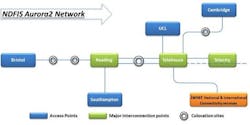Scientists from ORC unveil first results using new National Dark Fibre Infrastructure
Researchers from the University of Southampton's Optoelectronics Research Centre (ORC; Southampton, England) will reveal the first research results from the UK's new National Dark Fibre Infrastructure Service (NDFIS) this week at the ECOC conference (Valencia, Spain; 27 Sept. to 1 Oct., 2015).
Dark fiber is optical fiber that is deployed but is separate from the normal fiber-optic infrastructure, allowing users to access it at the optical data level rather than the electrical data level as in conventional communications networks. This enables users—primarily researchers—to experiment with novel communication techniques, such as high-order optical modulation or quantum communication.
Periklis Petropoulos, a professor at the ORC, explored the use of new optical signal-processing technologies to meet the demand for high capacity in future long-haul optical transmission systems. His team used a dedicated dark-fiber network, called Aurora2, to investigate the use of optical phase conjugation (OPC) to improve the quality of a transmitted optical signal.
Phase conjugator produces cleaner signals
"We demonstrated the use of an OPC system located in the middle of a 400 km deployed transmission link that effectively doubles the transmission capacity of similar schemes," he says. "As multiple communication signals travel simultaneously down a long length of the same fiber, they gradually accumulate noise and lose their fidelity. We placed an OPC at the midpoint of the distance to be traveled and this inversed the properties of the signals, forcing the noise accumulated in the second half of the link to negate the effects of the noise in the first half. This meant the signals at the end of the transmission line appeared cleaner than they would be without the use of the phase conjugator."
These were the first experiments the team carried out using the transmission line of the Aurora2 National Dark Fibre Infrastructure, Petropoulos notes. "Using a field-installed transmission line made the experiment much more challenging, but also made the results much more relevant and useful in understanding what the technology is capable of. Demonstrations such as this one show how optics can be used to improve the transmission of very high-capacity signals over long distances."
A paper detailing the team's research and findings will be presented at ECOC.
The NDFIS was set up with £2.5 million of UK Engineering and Physical Sciences Research Council (EPSRC) funding to support research on optical communication networks and the future Internet. The five-year project is led by University College London and comprises a consortium of the universities of Bristol, Cambridge, and Southampton. The NDFIS provides access to the dedicated Aurora2 dark-fiber network connecting these universities, with onward connection to European and worldwide research networks via telecommunications facilities in London.
Source: ORC

John Wallace | Senior Technical Editor (1998-2022)
John Wallace was with Laser Focus World for nearly 25 years, retiring in late June 2022. He obtained a bachelor's degree in mechanical engineering and physics at Rutgers University and a master's in optical engineering at the University of Rochester. Before becoming an editor, John worked as an engineer at RCA, Exxon, Eastman Kodak, and GCA Corporation.
